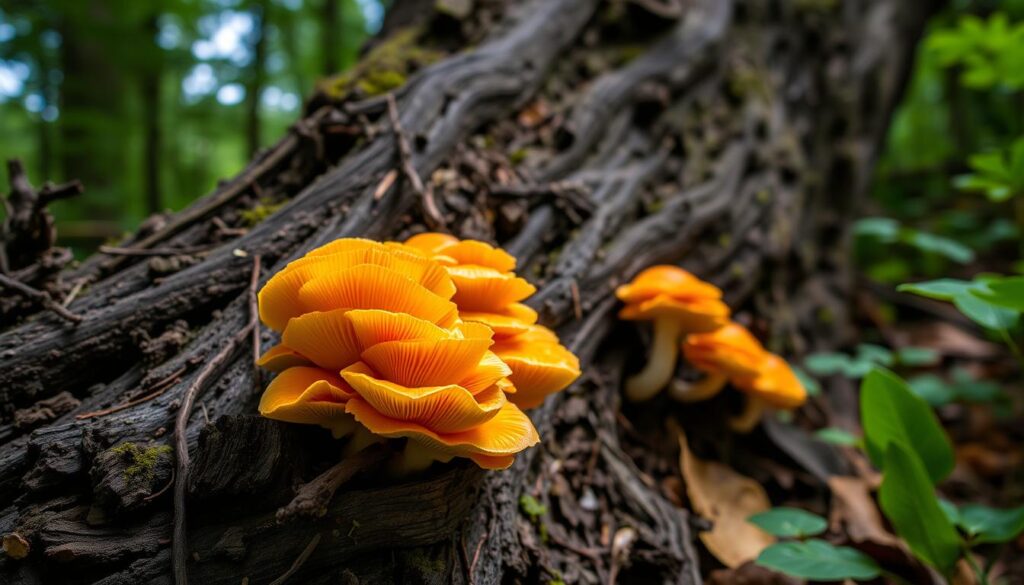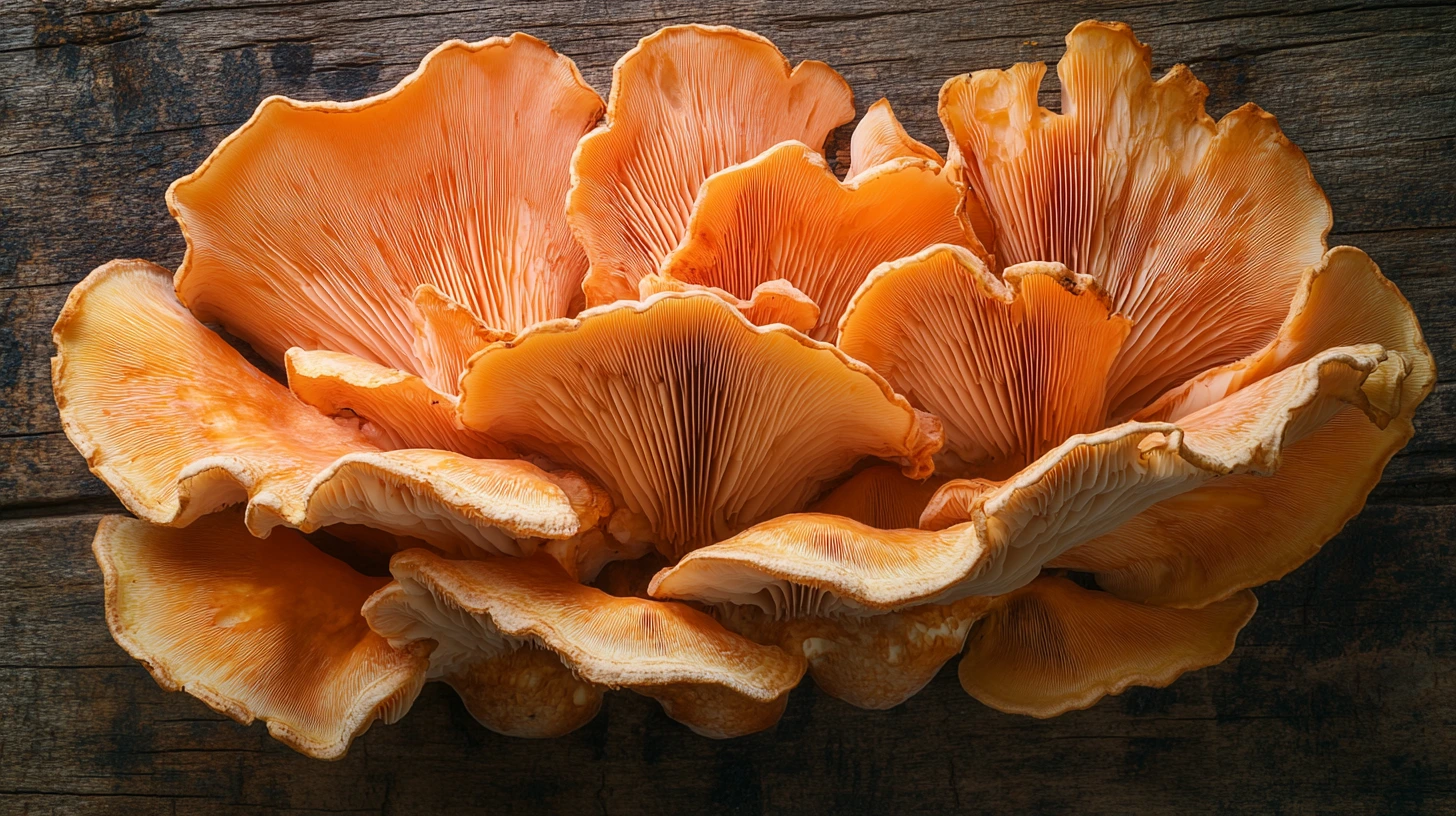Imagine walking through a forest, the leaves crunching under your feet. The air is filled with the scent of earth and pine. You see vibrant orange caps peeking from a tree’s base—this is the Chicken of the Woods mushroom.
Foraging for mushrooms is exciting. But this mushroom is special. It’s not just beautiful; it’s also great to eat. This makes it a favorite among cooks and foragers.
In this guide, you’ll explore the world of Chicken of the Woods mushrooms. You’ll learn about their looks, where they grow, and how to find them. You’ll also discover how to use them in your cooking. So, whether you’re new to foraging or already love mushrooms, this guide will spark your interest in nature’s bounty.
Key Takeaways
- Chicken of the Woods mushrooms, easily spotted from nearly 100 yards away, grow exclusively on dead trees or logs.
- These mushrooms are typically bright orange on top with a solid cream to yellow underside, boasting a smooth surface without stems or gills.
- Foraging for these mushrooms is best during early spring to late fall, with peak months in September and October.
- Younger mushrooms are tender, while older varieties may become tough and buggy, thus requiring careful selection during your foraging adventures.
- Proper storage is crucial: refrigerated, they last about a week, and they freeze well when cleaned and vacuum sealed.
Table of Contents
What Are Chicken of the Woods Mushrooms?
Chicken of the Woods mushrooms are special because of their look and taste. They belong to the Laetiporus family. You can find them growing in big clusters on trees, looking like shelves.
Their bright colors and textures make them stand out. This is why foragers and chefs love them so much.
Description and Characteristics
Chicken of the Woods mushrooms have caps that are 2 to 12 inches wide. Their surfaces are smooth or slightly wrinkled. They don’t have gills like other mushrooms.
Instead, their undersides have lots of small pores. These mushrooms grow on dead or dying hardwood trees, like oak, maple, and beech.
Common Species of Chicken of the Woods
There are many types of Chicken of the Woods mushrooms. Each one has its own look. Here’s a table with some of the most well-known ones:
| Species | Description | Habitat |
|---|---|---|
| Laetiporus sulphureus | Vibrant orange to yellow hues | Dead or decaying hardwood (especially oak) |
| Laetiporus cincinnatus | Creamy-colored underside | Diverse hardwoods |
| Laetiporus gilbertsonii | Pale pinkish-orange caps | Hardwood species such as oak and sweet chestnut |
These mushrooms are not just tasty; they’re also beautiful. They’re full of nutrients like potassium, vitamin A, and vitamin C. Adding them to your meals can make your diet healthier.
Where Does Chicken of the Woods Grow?
Knowing where chicken of the woods mushrooms grow can really help your foraging. These mushrooms love deciduous woodlands and often grow on tree trunks and stumps. If you’re into finding wild mushrooms, it’s key to know which trees they like.
Habitat and Tree Preferences
Chicken of the woods mushrooms prefer growing on hardwoods like oaks, maples, and beeches. They like humid, low spots and cooler weather. You can find them on tree trunks or injured roots, making them easy to spot.
These mushrooms can keep growing on the same tree for years, as long as the wood doesn’t fully rot. They grow in layers, looking like small shelves or shingles. This unique look helps you identify them.
Best Time for Foraging
The best time to find chicken of the woods is from late spring to fall. They grow best after heavy rains in September and October. Knowing when to look can make your foraging trip more successful.
| Season | Typical Growth Period | Conditions for Optimal Growth |
|---|---|---|
| Late Spring | May – June | Warm, moist conditions |
| Summer | July – August | High humidity |
| Fall | September – October | After heavy rainfall |
With this info, you can head out to find chicken of the woods mushrooms. It will improve your foraging skills.
How to Identify Chicken of the Woods Mushrooms
Identifying Chicken of the Woods mushrooms is fun for both new and seasoned foragers. Known as Laetiporus, this species is easy to spot because of its unique features. Knowing these traits helps you pick the right mushrooms to eat.
Physical Features
Chicken of the Woods mushrooms have fan-shaped caps that are 2 to 12 inches wide. Their texture can be smooth or slightly wavy. What makes them stand out is the lack of a big stem; they grow right out of the wood.
Some species have small pores on the underside instead of gills. This helps in identifying them.
Color Variations and Maturity Stages
The caps of Chicken of the Woods mushrooms start yellow or orange and fade to lighter shades as they grow older. Young mushrooms are best to eat because they are fresh and tender. Older ones can be tougher and woodier.

Chicken of the Woods Mushroom Look-Alikes
Foraging for chicken of the woods mushroom requires knowing the safe types and avoiding toxic ones. Misidentification can be dangerous. Jack-o-lanterns and velvet top fungus look similar but have key differences.
Identifying Safe Varieties
Some mushrooms look like chicken of the woods in the wild. Knowing the safe ones makes foraging better. Edible mushrooms like Hen of the Woods have unique features.
Chicken of the woods has a fan-shaped cap with fine pores. Jack-o-lantern mushrooms have true gills. Knowing these differences is important for safety and fun.
Toxic Look-Alikes to Avoid
It’s crucial to know the toxic mushrooms. The Jack O’Lantern mushroom is poisonous, causing stomach issues and nervous system problems. Other mushrooms, like Black Staining Polypore and Giant Polypore, can cause stomach discomfort.
Learning about these dangerous mushrooms helps avoid bad foraging experiences.
| Mushroom Name | Characteristics | Edibility |
|---|---|---|
| Chicken of the Woods | Bright yellow to orange, fan-shaped cap with fine pores | Edible |
| Jack O’Lantern | Bioluminescent, has true gills, orange to yellow color | Toxic |
| Cinnabar Polypore | Bright red-orange, larger pores | Not edible |
| Black Staining Polypore | Black fibrous stem, irregular pores | Not deadly, but can cause discomfort |
| Giant Polypore | Round, irregular pores that secrete liquid when squeezed | Not edible, can cause digestive issues |
How to Harvest Chicken of the Woods Mushrooms
Harvesting Chicken of the Woods mushrooms needs careful attention and best practices. Knowing when and how to pick them can make your mushroom hunting better. Using good mushroom hunting tips helps you get the best taste and texture.
Best Practices for Harvesting
When harvesting Chicken of the Woods, a sharp knife is your best friend. Cut the mushrooms from the tree carefully to avoid harming the wood. This helps the tree grow more mushrooms in the future.
Take only what you need, usually 5 to 10 pounds at a time. Remember, one tree can give almost 30 pounds. But, it’s important to leave enough for the tree to grow more.
Timing for Optimal Freshness
The right time to pick Chicken of the Woods mushrooms is key. You have only 2-3 days before they start to spoil. Check them every day for firmness and color, as these are signs of freshness.
Harvesting is best from late spring to early autumn, depending on where you are. In warmer places, you might find them early. In cooler areas, it might be August or September before they appear.
Is it possible to grow Chicken of the Woods mushrooms at home?
Yes, you can cultivate them yourself. You can do it indoors or outdoors. Outdoor growing is simpler for beginners. Indoor growing is harder but better for experts.
For outdoor growing, use hardwood logs or stumps. Oak or green ash logs work best.
To grow chicken of the woods mushrooms, follow these steps:
- Select freshly cut hardwood logs, ideally not more than a few weeks old.
- Use logs that are between 8″x8″ and 11″x11″ in size.
- Make sure each log weighs at least two pounds for effective mushroom cultivation.
- Inoculate the logs by drilling holes, inserting sawdust spawn (1 to 1½ cups per log), and sealing with wax.
- Maintain an ideal incubation temperature of 55-70°F for about 2-3 months.
- Be vigilant during the sterilization process, with pressure cooking at 15 psi for 120 minutes being the most effective method.
- Alternatively, steaming for at least 3 hours will reduce contamination, with 6 hours being recommended for the lowest risk.
- Fruiting typically begins in summer to early fall, approximately one year after planting.

Logs can bear fruit for several years after planting. You might get many harvests a year, depending on the environment. When you harvest, the mushrooms have a bright yellow surface and may grow in clusters.
To grow mushrooms well, be patient and watch out for contamination. It can really hurt your yield.
What Does Chicken of the Woods Mushroom Taste Like?
The Chicken of the Woods mushroom has a unique taste that excites food lovers. It tastes mild, with hints of lemon, similar to chicken or seafood. This makes it a great meat substitute for vegetarians and vegans.
Its versatility lets you try many recipes. You can turn your meals into something truly special.
Flavor Profile and Cooking Uses
This mushroom looks like cooked chicken breast. It’s white and fibrous. This makes it perfect for many dishes.
You can sauté, roast, or fry it to enhance its taste. It’s great in pasta, curries, or as a sandwich filling. To cook it well, sauté it gently before freezing.
Comparisons to Other Mushrooms
Chicken of the Woods is different from other mushrooms because it doesn’t have gills. It has about 14 grams of protein per 100 grams, making it low in fat. This makes it good for a healthy diet.
It absorbs flavors well, making it a favorite in Italian and Mediterranean dishes. It’s great in risottos and pizzas.
How to Clean Chicken of the Woods Mushrooms
Cleaning chicken of the woods mushrooms is key to bringing out their delicious flavors. These mushrooms are delicate and need gentle care. Using the right cleaning tips will make cooking them a breeze and ensure a tasty meal.
Cleaning Techniques
Begin by gently brushing the mushrooms with a soft-bristle brush or a damp cloth. Don’t soak them in water, as they absorb moisture quickly. If there’s stubborn dirt, a quick rinse under cold water is okay. Then, dry them with a towel.
When trimming, remove tough or woody parts, especially at the edges and base. This makes them more enjoyable to eat. After cleaning, let them air dry for a few minutes. This step helps keep their texture just right for different cooking methods.

Conclusion
Chicken of the woods mushrooms are a great addition to your cooking. They offer many health benefits and can grow in large amounts. This makes them a tasty and satisfying meat substitute in many dishes.
Learning to identify, harvest, and prepare these mushrooms is key. They are packed with nutrients and have special properties. These include antioxidants, antibacterial effects, and may even help with hormonal balance and diabetes control.
Exploring foraged foods is exciting, and it’s good for the environment too. By choosing local chicken of the woods, you enjoy tasty meals and help the planet. Start your journey with edible mushrooms and enjoy the delicious changes they bring to your life.


1 thought on “What is Chicken of the Woods Mushroom? A Complete Guide”
Comments are closed.